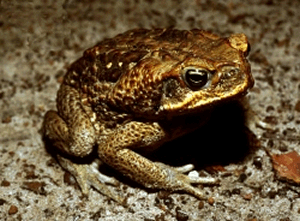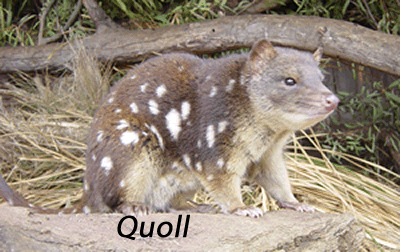Ecosystem-biological controls.
The Cane Toad Bufo marinus

In 1935 Australia acquired some 100 toads, for the control of the Sugar Cane beetle (Dermolepida albohirtum). Up to this point no toads had evolved in Australia. The toads were released in Gordonvale south of Cairns but, as proved later, had no impact on the sugar can beetle.
With no natural predators and a reproductive capacity that far exceeds that of any native frog species, females are known to lay on average 33,000 eggs, the Cane Toad has managed to become, arguably, one of Australia's' worst environmental disasters.
Toads develop quicker from egg to adult than any frog species in Australia. This helps them out compete all other species.
Every stage of the Cane Toad's life cycle is poisonous. This has a devastating effect on local fauna that eat the toads from small fish to large lizards like the goannas.

Giant white-tailed Uromys: Uromys caudimaculatus
This native Australian rat feeds on animal remains and has evolved habits to cope with the Cane Toad's venom. It only eats the legs of the toad.
The first wave of the toad invasion kills the animals that prey on them, such as quolls and goannas.
Months later, as the toads start to hatch, the frill necked lizards are the next to go as they eat the tiny toads.
In 2006 it was reported by Aboriginal elders in Arnhem Land that no longer were goannas seen wandering in the bush and a number of their traditional food sources were disappearing. A number of freshwater crocodiles have also been found floating belly up as a result of eating toads.

